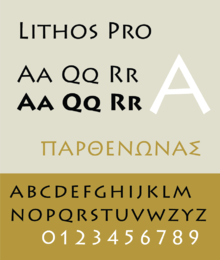Lithos
 | |
| Category | Sans-serif |
|---|---|
| Classification | Incised, Display |
| Designer(s) | Carol Twombly |
| Foundry | Adobe Type |
| Date released | 1989 |
Lithos is a glyphic sans-serif typeface designed by Carol Twombly in 1989 for Adobe Systems. Lithos is inspired by the unadorned, geometric letterforms of the engravings found on Ancient Greek public buildings. The typeface consists of only capital letters, and comes in five weights, with no italics.
According to Twombly, Lithos only used Greek inscriptions as inspiration, making Lithos more of a modern reinterpretation than a faithful reproduction. Twombly also designed Trajan and Charlemagne based respectively on ancient Roman and Byzantine inscriptions. Those typefaces, unlike Lithos, were modeled more directly upon their historical counterparts. One example of Lithos' departure from historical accuracy is the inclusion of bold weights, which never existed in historical Greek inscriptions.
Publications associated with African, African-American and Southwestern cultures have used Lithos for its "ethnic" feel, even if it is the wrong ethnicity. Lithos has also become something of a generic stand-in whenever a "primitive" feel is desired. For this reason, Lithos has been compared to Rudolf Koch's typeface, Neuland, which was originally intended to be a modern reinterpretation of blackletter, but received similarly broad use.
Lithos Pro
In 2000, Adobe released the OpenType version called Lithos Pro, which included Adobe CE, Adobe Western 2, Greek character sets support, and small caps in the lowercase positions. OpenType features include alternates, case forms, proportional lining figures, small caps.
Lithos in popular culture
Lithos was the resident typeface of MTV during the late 1980s and early 1990s.
Lithos was used on the reverse side of the 2009 one dollar coin produced by the United States Mint. The scene depicted on the coin is one of a native American planting corn.[citation needed]
Lithos is also used in the title typeface of the Very Short Introduction published by the Oxford University Press.
References
- Giampietro, Rob. "New Black Face" Giampietro+Smith Studio taken from Letterspace Fall/Winter 2004. Retrieved May 30, 2007.
- "Lithos Pro" Adobe.com. Retrieved May 30, 2007.
- Adobe - Fonts: Lithos